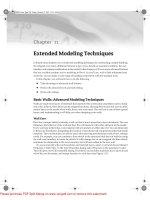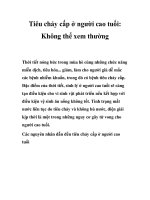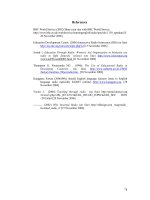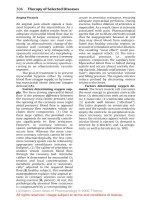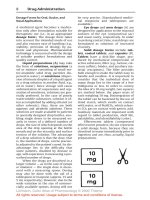Tài liệu Color Atlas of Pharmacology (Part 12): Inhibitors of the RAA System ppt
Bạn đang xem bản rút gọn của tài liệu. Xem và tải ngay bản đầy đủ của tài liệu tại đây (656.81 KB, 14 trang )
Inhibitors of the RAA System
Angiotensin-converting enzyme (ACE)
is a component of the antihypotensive
renin-angiotensin-aldosterone (RAA)
system. Renin is produced by special-
ized cells in the wall of the afferent ar-
teriole of the renal glomerulus. These
cells belong to the juxtaglomerular ap-
paratus of the nephron, the site of con-
tact between afferent arteriole and dis-
tal tubule, and play an important part in
controlling nephron function. Stimuli
eliciting release of renin are: a drop in
renal perfusion pressure, decreased rate
of delivery of Na
+
or Cl
–
to the distal tu-
bules, as well as !-adrenoceptor-medi-
ated sympathoactivation. The glycopro-
tein renin enzymatically cleaves the
decapeptide angiotensin I from its cir-
culating precursor substrate angiotensi-
nogen. ACE, in turn, produces biologi-
cally active angiotensin II (ANG II) from
angiotensin I (ANG I).
ACE is a rather nonspecific pepti-
dase that can cleave C-terminal dipep-
tides from various peptides (dipeptidyl
carboxypeptidase). As “kininase II,” it
contributes to the inactivation of kinins,
such as bradykinin. ACE is also present in
blood plasma; however, enzyme local-
ized in the luminal side of vascular endo-
thelium is primarily responsible for the
formation of angiotensin II. The lung is
rich in ACE, but kidneys, heart, and other
organs also contain the enzyme.
Angiotensin II can raise blood pres-
sure in different ways, including (1)
vasoconstriction in both the arterial and
venous limbs of the circulation; (2)
stimulation of aldosterone secretion,
leading to increased renal reabsorption
of NaCl and water, hence an increased
blood volume; (3) a central increase in
sympathotonus and, peripherally, en-
hancement of the release and effects of
norepinephrine.
ACE inhibitors, such as captopril
and enalaprilat, the active metabolite of
enalapril, occupy the enzyme as false
substrates. Affinity significantly influ-
ences efficacy and rate of elimination.
Enalaprilat has a stronger and longer-
lasting effect than does captopril. Indi-
cations are hypertension and cardiac
failure.
Lowering of an elevated blood pres-
sure is predominantly brought about by
diminished production of angiotensin II.
Impaired degradation of kinins that ex-
ert vasodilating actions may contribute
to the effect.
In heart failure, cardiac output rises
again because ventricular afterload di-
minishes due to a fall in peripheral re-
sistance. Venous congestion abates as a
result of (1) increased cardiac output
and (2) reduction in venous return (de-
creased aldosterone secretion, de-
creased tonus of venous capacitance
vessels).
Undesired effects. The magnitude
of the antihypertensive effect of ACE in-
hibitors depends on the functional state
of the RAA system. When the latter has
been activated by loss of electrolytes
and water (resulting from treatment
with diuretic drugs), cardiac failure, or
renal arterial stenosis, administration of
ACE inhibitors may initially cause an ex-
cessive fall in blood pressure. In renal
arterial stenosis, the RAA system may be
needed for maintaining renal function
and ACE inhibitors may precipitate re-
nal failure. Dry cough is a fairly frequent
side effect, possibly caused by reduced
inactivation of kinins in the bronchial
mucosa. Rarely, disturbances of taste
sensation, exanthema, neutropenia,
proteinuria, and angioneurotic edema
may occur. In most cases, ACE inhibitors
are well tolerated and effective. Newer
analogues include lisinopril, perindo-
pril, ramipril, quinapril, fosinopril, be-
nazepril, cilazapril, and trandolapril.
Antagonists at angiotensin II re-
ceptors. Two receptor subtypes can be
distinguished: AT1, which mediates the
above actions of AT II; and AT2, whose
physiological role is still unclear. The
sartans (candesartan, eprosartan, irbe-
sartan, losartan, and valsartan) are AT1
antagonists that reliably lower high
blood pressure. They do not inhibit
degradation of kinins and cough is not a
frequent side-effect.
124 Inhibitors of the RAA System
Lüllmann, Color Atlas of Pharmacology © 2000 Thieme
All rights reserved. Usage subject to terms and conditions of license.
Inhibitors of the RAA System 125
Renin
A. Renin-angiotensin-aldosterone system and inhibitors
Kidney
Angiotensin I (Ang I)
COOH
ACE inhibitors
Captopril
Enalaprilat Enalapril
Ang I Kinins
Ang II
Degradation
products
Vascular
endothelium
H
2
N
Resistance vessels
K
+
Angiotensinogen
("
2
-globulin)
RR
Vasoconstriction
Cardiac
output
venous
capacitance
vessels
Sympatho-
activation
H
2
O
NaCl
Arterial
blood
pressure
Venous
supply
Peripheral
resistance
ACE
Kininase
II
ACE
Angiotensin I-
converting-
enzyme
Dipeptidyl-Carboxypeptidase
Losartan
Receptors
Aldosterone
secretion
AT
1
-receptor antagonists
Angiotensin II
N N
Cl
H
NN
N N
H
3
C
CH
2
OH
O O
O
N
HOOC
CH
3
CH
3
HOOC
N
O
SH
CH
3
Lüllmann, Color Atlas of Pharmacology © 2000 Thieme
All rights reserved. Usage subject to terms and conditions of license.
Drugs Used to Influence Smooth Muscle
Organs
Bronchodilators. Narrowing of bron-
chioles raises airway resistance, e.g., in
bronchial or bronchitic asthma. Several
substances that are employed as bron-
chodilators are described elsewhere in
more detail: !
2
-sympathomimetics (p.
84, given by pulmonary, parenteral, or
oral route), the methylxanthine theo-
phylline (p. 326, given parenterally or
orally), as well as the parasympatholytic
ipratropium (pp. 104, 107, given by in-
halation).
Spasmolytics. N-Butylscopolamine
(p. 104) is used for the relief of painful
spasms of the biliary or ureteral ducts.
Its poor absorption (N.B. quaternary N;
absorption rate <10%) necessitates par-
enteral administration. Because the
therapeutic effect is usually weak, a po-
tent analgesic is given concurrently, e.g.,
the opioid meperidine. Note that some
spasms of intestinal musculature can be
effectively relieved by organic nitrates
(in biliary colic) or by nifedipine (esoph-
ageal hypertension and achalasia).
Myometrial relaxants (Tocolyt-
ics). !
2
-Sympathomimetics such as fe-
noterol or ritodrine, given orally or par-
enterally, can prevent premature labor
or interrupt labor in progress when dan-
gerous complications necessitate cesar-
ean section. Tachycardia is a side effect
produced reflexly because of !
2
-mediat-
ed vasodilation or direct stimulation of
cardiac !
1
-receptors. Magnesium sul-
fate, given i.v., is a useful alternative
when !-mimetics are contraindicated,
but must be carefully titrated because
its nonspecific calcium antagonism
leads to blockade of cardiac impulse
conduction and of neuromuscular
transmission.
Myometrial stimulants. The neu-
rohypophyseal hormone oxytocin (p.
242) is given parenterally (or by the na-
sal or buccal route) before, during, or af-
ter labor in order to prompt uterine con-
tractions or to enhance them. Certain
prostaglandins or analogues of them (p.
196; F
2"
: dinoprost; E
2
: dinoprostone,
misoprostol, sulprostone) are capable of
inducing rhythmic uterine contractions
and cervical relaxation at any time. They
are mostly employed as abortifacients
(oral or vaginal application of misopros-
tol in combination with mifepristone [p.
256]).
Ergot alkaloids are obtained from
Secale cornutum (ergot), the sclerotium
of a fungus (Claviceps purpurea) parasi-
tizing rye. Consumption of flour from
contaminated grain was once the cause
of epidemic poisonings (ergotism) char-
acterized by gangrene of the extremities
(St. Anthony’s fire) and CNS disturbanc-
es (hallucinations).
Ergot alkaloids contain lysergic acid
(formula in A shows an amide). They act
on uterine and vascular muscle. Ergo-
metrine particularly stimulates the uter-
us. It readily induces a tonic contraction
of the myometrium (tetanus uteri). This
jeopardizes placental blood flow and fe-
tal O
2
supply. The semisynthetic deriva-
tive methylergometrine is therefore
used only after delivery for uterine con-
tractions that are too weak.
Ergotamine, as well as the ergotox-
ine alkaloids (ergocristine, ergocryp-
tine, ergocornine), have a predominant-
ly vascular action. Depending on the in-
itial caliber, constriction or dilation may
be elicited. The mechanism of action is
unclear; a mixed antagonism at "-
adrenoceptors and agonism at 5-HT-re-
ceptors may be important. Ergotamine
is used in the treatment of migraine (p.
322). Its congener, dihydroergotamine,
is furthermore employed in orthostatic
complaints (p. 314).
Other lysergic acid derivatives are
the 5-HT antagonist methysergide, the
dopamine agonists bromocriptine, per-
golide, and cabergolide (pp. 114, 188),
and the hallucinogen lysergic acid di-
ethylamide (LSD, p. 240).
126 Drugs Acting on Smooth Muscle
Lüllmann, Color Atlas of Pharmacology © 2000 Thieme
All rights reserved. Usage subject to terms and conditions of license.
Drugs Acting on Smooth Muscle 127
A. Drugs used to alter smooth muscle function
Bronchial asthma
Bronchodilation Spasmolysis
Theophylline N-Butylscopolamine
Scopolamine
Biliary / renal colic
Inhibition of labor
Induction of labor
Oxytocin
Prostaglandins
F
2"
, E
2
Nitrates
e.g., nitroglycerin
!
2
-Sympathomimetics
e.g., fenoterol
Ipratropium
Secale cornutum
(ergot)
Fungus:
Claviceps purpurea
e.g., ergometrine
Contraindication:
before delivery
Indication:
postpartum
uterine atonia
e.g., ergotamine
O
2
O
2
Tonic contraction of uterus
!
2
-
Sympathomimetics
Effect on
vasomotor tone
Secale alkaloids
Spasm of
smooth muscle
Fixation of lumen at intemediate caliber
Lüllmann, Color Atlas of Pharmacology © 2000 Thieme
All rights reserved. Usage subject to terms and conditions of license.
Overview of Modes of Action (A)
1. The pumping capacity of the heart is
regulated by sympathetic and parasym-
pathetic nerves (pp. 84, 105). Drugs ca-
pable of interfering with autonomic
nervous function therefore provide a
means of influencing cardiac perfor-
mance. Thus, anxiolytics of the benzo-
diazepine type (p. 226), such as diaze-
pam, can be employed in myocardial in-
farction to suppress sympathoactiva-
tion due to life-threatening distress.
Under the influence of antiadrenergic
agents (p. 96), used to lower an elevated
blood pressure, cardiac work is de-
creased. Ganglionic blockers (p. 108)
are used in managing hypertensive
emergencies. Parasympatholytics (p.
104) and !-blockers (p. 92) prevent the
transmission of autonomic nerve im-
pulses to heart muscle cells by blocking
the respective receptors.
2. An isolated mammalian heart
whose extrinsic nervous connections
have been severed will beat spontane-
ously for hours if it is supplied with a
nutrient medium via the aortic trunk
and coronary arteries (Langendorff
preparation). In such a preparation, only
those drugs that act directly on cardio-
myocytes will alter contractile force and
beating rate.
Parasympathomimetics and sym-
pathomimetics act at membrane re-
ceptors for visceromotor neurotrans-
mitters. The plasmalemma also harbors
the sites of action of cardiac glycosides
(the Na/K-ATPases, p. 130), of Ca
2+
an-
tagonists (Ca
2+
channels, p. 122), and of
agents that block Na
+
channels (local
anesthetics; p. 134, p. 204). An intracel-
lular site is the target for phosphodies-
terase inhibitors (e.g., amrinone, p. 132).
3. Mention should also be made of
the possibility of affecting cardiac func-
tion in angina pectoris (p. 306) or con-
gestive heart failure (p. 132) by reduc-
ing venous return, peripheral resis-
tance, or both, with the aid of vasodila-
tors; and by reducing sympathetic drive
applying !-blockers.
Events Underlying Contraction and
Relaxation (B)
The signal triggering contraction is a
propagated action potential (AP) gener-
ated in the sinoatrial node. Depolariza-
tion of the plasmalemma leads to a rap-
id rise in cytosolic Ca
2+
levels, which
causes the contractile filaments to
shorten (electromechanical coupling).
The level of Ca
2+
concentration attained
determines the degree of shortening,
i.e., the force of contraction. Sources of
Ca
2+
are: a) extracellular Ca
2+
entering
the cell through voltage-gated Ca
2+
channels; b) Ca
2+
stored in membranous
sacs of the sarcoplasmic reticulum (SR);
c) Ca
2+
bound to the inside of the plas-
malemma. The plasmalemma of cardio-
myocytes extends into the cell interior
in the form of tubular invaginations
(transverse tubuli).
The trigger signal for relaxation is
the return of the membrane potential to
its resting level. During repolarization,
Ca
2+
levels fall below the threshold for
activation of the myofilaments (3҂10
–7
M), as the plasmalemmal binding sites
regain their binding capacity; the SR
pumps Ca
2+
into its interior; and Ca
2+
that entered the cytosol during systole
is again extruded by plasmalemmal
Ca
2+
-ATPases with expenditure of ener-
gy. In addition, a carrier (antiporter),
utilizing the transmembrane Na
+
gradi-
ent as energy source, transports Ca
2+
out
of the cell in exchange for Na
+
moving
down its transmembrane gradient
(Na
+
/Ca
2+
exchange).
128 Cardiac Drugs
Lüllmann, Color Atlas of Pharmacology © 2000 Thieme
All rights reserved. Usage subject to terms and conditions of license.
Cardiac Drugs 129
Relaxation
Ca
2
+
10
-
3
M
B. Processes in myocardial contraction and relaxation
A. Possible mechanisms for influencing heart function
Drugs with
indirect action
Drugs with direct action
Nutrient solution
Force
Rate
!-Sympathomimetics
Phosphodiesterase inhibitors
Cardiac
glycosides
Parasympathomimetics
Catamphiphilic
Ca-antagonists
Local anesthetics
Na
+
Ca-ATPase
300 ms
Para-
sympathetic
Sympathetic
Epinephrine
Psychotropic
drugs
Sympatholytics
Ganglionic
blockers
Force Rate
Contraction
electrical
excitation
Ca-channel
Sarcoplasmic
reticulum
Heart muscle cell
Transverse
tubule
Ca
2
+
10
-
3
M
Ca
2+
10
-5
M
Ca
2+
10
-7
M
Ca
2+
Na
+
Ca
2+
Na
+
Ca
2+
Na/Ca-
exchange
Plasma-
lemmal
binding sites
0
-80
Membrane potential
[mV]
t
Force
t
Contraction
Action potential
Lüllmann, Color Atlas of Pharmacology © 2000 Thieme
All rights reserved. Usage subject to terms and conditions of license.
Cardiac Glycosides
Diverse plants (A) are sources of sugar-
containing compounds (glycosides) that
also contain a steroid ring (structural
formulas, p. 133) and augment the con-
tractile force of heart muscle (B): cardio-
tonic glycosides. cardiosteroids, or “digi-
talis.”
If the inotropic, “therapeutic” dose
is exceeded by a small increment, signs
of poisoning appear: arrhythmia and
contracture (B). The narrow therapeutic
margin can be explained by the mecha-
nism of action.
Cardiac glycosides (CG) bind to the
extracellular side of Na
+
/K
+
-ATPases of
cardiomyocytes and inhibit enzyme ac-
tivity. The Na
+
/K
+
-ATPases operate to
pump out Na
+
leaked into the cell and to
retrieve K
+
leaked from the cell. In this
manner, they maintain the transmem-
brane gradients for K
+
and Na
+
, the neg-
ative resting membrane potential, and
the normal electrical excitability of the
cell membrane. When part of the en-
zyme is occupied and inhibited by CG,
the unoccupied remainder can increase
its level of activity and maintain Na
+
and
K
+
transport. The effective stimulus is a
small elevation of intracellular Na
+
con-
centration (normally approx. 7 mM).
Concomitantly, the amount of Ca
2+
mo-
bilized during systole and, thus, con-
tractile force, increases. It is generally
thought that the underlying cause is the
decrease in the Na
+
transmembrane
gradient, i.e., the driving force for the
Na
+
/Ca
2+
exchange (p. 128), allowing the
intracellular Ca
2+
level to rise. When too
many ATPases are blocked, K
+
and Na
+
homeostasis is deranged; the mem-
brane potential falls, arrhythmias occur.
Flooding with Ca
2+
prevents relaxation
during diastole, resulting in contracture.
The CNS effects of CG (C) are also
due to binding to Na
+
/K
+
-ATPases. En-
hanced vagal nerve activity causes a de-
crease in sinoatrial beating rate and ve-
locity of atrioventricular conduction. In
patients with heart failure, improved
circulation also contributes to the re-
duction in heart rate. Stimulation of the
area postrema leads to nausea and vom-
iting. Disturbances in color vision are
evident.
Indications for CG are: (1) chronic
congestive heart failure; and (2) atrial
fibrillation or flutter, where inhibition of
AV conduction protects the ventricles
from excessive atrial impulse activity
and thereby improves cardiac perfor-
mance (D). Occasionally, sinus rhythm
is restored.
Signs of intoxication are: (1) car-
diac arrhythmias, which under certain
circumstances are life-threatening, e.g.,
sinus bradycardia, AV-block, ventricular
extrasystoles, ventricular fibrillation
(ECG); (2) CNS disturbances — altered
color vision (xanthopsia), agitation,
confusion, nightmares, hallucinations;
(3) gastrointestinal — anorexia, nausea,
vomiting, diarrhea; (4) renal — loss of
electrolytes and water, which must be
differentiated from mobilization of ac-
cumulated edema fluid that occurs with
therapeutic dosage.
Therapy of intoxication: adminis-
tration of K
+
, which inter alia reduces
binding of CG, but may impair AV-con-
duction; administration of antiarrhyth-
mics, such as phenytoin or lidocaine (p.
136); oral administration of colestyra-
mine (p. 154, 156) for binding and pre-
venting absorption of digitoxin present
in the intestines (enterohepatic cycle);
injection of antibody (Fab) fragments
that bind and inactivate digitoxin and
digoxin. Compared with full antibodies,
fragments have superior tissue penet-
rability, more rapid renal elimination,
and lower antigenicity.
130 Cardiac Drugs
Lüllmann, Color Atlas of Pharmacology © 2000 Thieme
All rights reserved. Usage subject to terms and conditions of license.
Cardiac Drugs 131
C. Cardiac glycoside effects on the CNS
A. Plants containing cardiac glycosides
B. Therapeutic and toxic effects of cardiac glycosides (CG)
Digitalis purpurea
Red foxglove
Convallaria
majalis
Lily of the valley
Helleborus niger
Christmas rose
Contraction
Time ´therapeutic´ ´toxic´ Dose of cardiac glycoside (CG)
Na
+
Na
+
K
+
Heart muscle cell
Ca
2+
K
+
K
+
Ca
2+
Na
+
K
+
Na
+
Disturbance of
color vision
Area postrema:
nausea, vomiting
"Re-entrant"
excitation in
atrial
fibrillation
Cardiac
glycoside
Decrease in
ventricular
rate
D. Cardiac glycoside effects in
atrial fibrillation
Coupling
Ca
2+
CG
CG
CG
CG
CG
Na/K-ATPase
Excitation of
N. vagus:
Heart rate
Arrhythmia Contracture
Lüllmann, Color Atlas of Pharmacology © 2000 Thieme
All rights reserved. Usage subject to terms and conditions of license.
The pharmacokinetics of cardiac
glycosides (A) are dictated by their po-
larity, i.e., the number of hydroxyl
groups. Membrane penetrability is vir-
tually nil in ouabain, high in digoxin,
and very high in digitoxin. Ouabain (g-
strophanthin) does not penetrate into
cells, be they intestinal epithelium, re-
nal tubular, or hepatic cells. At best, it is
suitable for acute intravenous induction
of glycoside therapy.
The absorption of digoxin depends
on the kind of galenical preparation
used and on absorptive conditions in
the intestine. Preparations are now of
such quality that the derivatives methyl-
digoxin and acetyldigoxin no longer offer
any advantage. Renal reabsorption is in-
complete; approx. 30% of the total
amount present in the body (s.c. full
“digitalizing” dose) is eliminated per
day. When renal function is impaired,
there is a risk of accumulation. Digi-
toxin undergoes virtually complete re-
absorption in gut and kidneys. There is
active hepatic biotransformation: cleav-
age of sugar moieties, hydroxylation at
C12 (yielding digoxin), and conjugation
to glucuronic acid. Conjugates secreted
with bile are subject to enterohepatic
cycling (p. 38); conjugates reaching the
blood are renally eliminated. In renal in-
sufficiency, there is no appreciable ac-
cumulation. When digitoxin is with-
drawn following overdosage, its effect
decays more slowly than does that of di-
goxin.
Other positive inotropic drugs.
The phosphodiesterase inhibitor am-
rinone (cAMP elevation, p. 66) can be
administered only parenterally for a
maximum of 14 d because it is poorly
tolerated. A closely related compound is
milrinone. In terms of their positive in-
otropic effect, !-sympathomimetics,
unlike dopamine (p. 114), are of little
therapeutic use; they are also arrhyth-
mogenic and the sensitivity of the !-re-
ceptor system declines during continu-
ous stimulation.
Treatment Principles in Chronic Heart
Failure
Myocardial insufficiency leads to a de-
crease in stroke volume and venous
congestion with formation of edema.
Administration of (thiazide) diuretics
(p. 62) offers a therapeutic approach of
proven efficacy that is brought about by
a decrease in circulating blood volume
(decreased venous return) and periph-
eral resistance, i.e., afterload. A similar
approach is intended with ACE-inhibi-
tors, which act by preventing the syn-
thesis of angiotensin II (ȇ vasoconstric-
tion) and reducing the secretion of al-
dosterone (ȇ fluid retention). In severe
cases of myocardial insufficiency, car-
diac glycosides may be added to aug-
ment cardiac force and to relieve the
symptoms of insufficiency.
In more recent times !-blocker on a
long term were found to improve car-
diac performance — particularly in idio-
pathic dilating cardiomyopathy — pro-
bably by preventing sympathetic over-
drive.
132 Cardiac Drugs
Substance Fraction Plasma concentr. Digitalizing Elimination Maintenance
absorbed free total dose dose
% (ng/mL) (mg) %/d (mg)
Digitoxin 100 ف1 ف20 ف1 10 ف0.1
Digoxin 50–90 ف1 ف1.5 ف1 30 ف0.3
Ouabain <1 ف1 ف1 0.5 no long-term use
Lüllmann, Color Atlas of Pharmacology © 2000 Thieme
All rights reserved. Usage subject to terms and conditions of license.
Cardiac Drugs 133
A. Pharmacokinetics of cardiac glycosides
Plasma
Albumin
Liver-
cell
Intestinal epithelium
Renal tubular
epithelium
Deconjugation
0%
35%
95%
Cleavage
of sugar
Conjugation
Digitoxin Digoxin
Plasma t
1
2
Ouabain
Digoxin
Digitoxin
9 h 2 – 3 days 5 – 7 days
Lüllmann, Color Atlas of Pharmacology © 2000 Thieme
All rights reserved. Usage subject to terms and conditions of license.
Antiarrhythmic Drugs
The electrical impulse for contraction
(propagated action potential; p. 136)
originates in pacemaker cells of the si-
noatrial node and spreads through the
atria, atrioventricular (AV) node, and
adjoining parts of the His-Purkinje fiber
system to the ventricles (A). Irregular-
ities of heart rhythm can interfere dan-
gerously with cardiac pumping func-
tion.
I. Drugs for selective control of si-
noatrial and AV nodes. In some forms
of arrhythmia, certain drugs can be used
that are capable of selectively facilitat-
ing and inhibiting (green and red ar-
rows, respectively) the pacemaker func-
tion of sinoatrial or atrioventricular
cells.
Sinus bradycardia. An abnormally
low sinoatrial impulse rate (<60/min)
can be raised by parasympatholytics.
The quaternary ipratropium is prefer-
able to atropine, because it lacks CNS
penetrability (p. 107). Sympathomimet-
ics also exert a positive chronotropic ac-
tion; they have the disadvantage of in-
creasing myocardial excitability (and
automaticity) and, thus, promoting ec-
topic impulse generation (tendency to
extrasystolic beats). In cardiac arrest
epinephrine can be used to reinitiate
heart beat.
Sinus tachycardia (resting rate
>100 beats/min). !-Blockers eliminate
sympathoexcitation and decrease car-
diac rate.
Atrial flutter or fibrillation. An ex-
cessive ventricular rate can be de-
creased by verapamil (p. 122) or cardiac
glycosides (p. 130). These drugs inhibit
impulse propagation through the AV
node, so that fewer impulses reach the
ventricles.
II. Nonspecific drug actions on
impulse generation and propagation.
Impulses originating at loci outside the
sinus node are seen in supraventricular
or ventricular extrasystoles, tachycardia,
atrial or ventricular flutter, and fibrilla-
tion. In these forms of rhythm disorders,
antiarrhythmics of the local anesthet-
ic, Na
+
-channel blocking type (B) are
used for both prophylaxis and therapy.
Local anesthetics inhibit electrical exci-
tation of nociceptive nerve fibers (p.
204); concomitant cardiac inhibition
(cardiodepression) is an unwanted ef-
fect. However, in certain types of ar-
rhythmias (see above), this effect is use-
ful. Local anesthetics are readily cleaved
(arrows) and unsuitable for oral admin-
istration (procaine, lidocaine). Given ju-
diciously, intravenous lidocaine is an ef-
fective antiarrhythmic. Procainamide
and mexiletine, congeners endowed
with greater metabolic stability, are ex-
amples of orally effective antiarrhyth-
mics. The desired and undesired effects
are inseparable. Thus, these antiar-
rhythmics not only depress electrical
excitability of cardiomyocytes (negative
bathmotropism, membrane stabiliza-
tion), but also lower sinoatrial rate (neg.
chronotropism), AV conduction (neg.
dromotropism), and force of contraction
(neg. inotropism). Interference with nor-
mal electrical activity can, not too para-
doxically, also induce cardiac arrhyth-
mias–arrhythmogenic action.
Inhibition of CNS neurons is the
underlying cause of neurological effects
such as vertigo, confusion, sensory dis-
turbances, and motor disturbances
(tremor, giddiness, ataxia, convulsions).
134 Cardiac Drugs
Lüllmann, Color Atlas of Pharmacology © 2000 Thieme
All rights reserved. Usage subject to terms and conditions of license.
Cardiac Drugs 135
B. Antiarrhythmics of the Na
+
-channel blocking type
A. Cardiac impulse generation and conduction
Main effect
Antiarrhythmic
effect
Adverse effects
CNS-disturbances
Arrhythmia
Cardiodepression
Para-
sympatholytics
!-Sympatho-
mimetics
!-Blocker
Verapamil
Cardiac
glycoside
(Vagal
stimulation)
Antiarrhythmics of the local anesthetic
(Na
+
-channel blocking) type:
Inhibition of impulse generation and conduction
Atrium
Sinus node
AV-node
Bundle of His
Ventricle
Tawara´s
node
Purkinje
fibers
Esterases
Procainamide
Mexiletine
Procaine
Lidocaine
Lüllmann, Color Atlas of Pharmacology © 2000 Thieme
All rights reserved. Usage subject to terms and conditions of license.
Electrophysiological Actions of
Antiarrhythmics of the Na
+
-Channel
Blocking Type
Action potential and ionic currents.
The transmembrane electrical potential
of cardiomyocytes can be recorded
through an intracellular microelectrode.
Upon electrical excitation, a characteris-
tic change occurs in membrane poten-
tial—the action potential (AP). Its under-
lying cause is a sequence of transient
ionic currents. During rapid depolariza-
tion (Phase 0), there is a short-lived in-
flux of Na
+
through the membrane. A
subsequent transient influx of Ca
2+
(as
well as of Na
+
) maintains the depola-
rization (Phase 2, plateau of AP). A de-
layed efflux of K
+
returns the membrane
potential (Phase 3, repolarization) to its
resting value (Phase 4). The velocity of
depolarization determines the speed at
which the AP propagates through the
myocardial syncytium.
Transmembrane ionic currents in-
volve proteinaceous membrane pores:
Na
+
, Ca
2+
, and K
+
channels. In A, the
phasic change in the functional state of
Na
+
channels during an action potential
is illustrated.
Effects of antiarrhythmics. Antiar-
rhythmics of the Na
+
-channel blocking
type reduce the probability that Na
+
channels will open upon membrane de-
polarization (“membrane stabiliza-
tion”). The potential consequences are
(A, bottom): 1) a reduction in the veloc-
ity of depolarization and a decrease in
the speed of impulse propagation; aber-
rant impulse propagation is impeded. 2)
Depolarization is entirely absent; patho-
logical impulse generation, e.g., in the
marginal zone of an infarction, is sup-
pressed. 3) The time required until a
new depolarization can be elicited, i.e.,
the refractory period, is increased; pro-
longation of the AP (see below) contrib-
utes to the increase in refractory period.
Consequently, premature excitation
with risk of fibrillation is prevented.
Mechanism of action. Na
+
-channel
blocking antiarrhythmics resemble
most local anesthetics in being cationic
amphiphilic molecules (p. 208, excep-
tion: phenytoin, p. 190). Possible molec-
ular mechanisms of their inhibitory ef-
fects are outlined on p. 204 in more de-
tail. Their low structural specificity is
reflected by a low selectivity towards
different cation channels. Besides the
Na
+
channel, Ca
2+
and K
+
channels are al-
so likely to be blocked. Accordingly, cat-
ionic amphiphilic antiarrhythmics af-
fect both the depolarization and repola-
rization phases. Depending on the sub-
stance, AP duration can be increased
(Class IA), decreased (Class IB), or re-
main the same (Class IC).
Antiarrhythmics representative
of these categories include: Class IA—
quinidine, procainamide, ajmaline, dis-
opyramide, propafenone; Class IB—lido-
caine, mexiletine, tocainide, as well as
phenytoin; Class IC—flecainide.
Note: With respect to classification,
!-blockers have been assigned to Class
II, and the Ca
2+
-channel blockers vera-
pamil and diltiazem to Class IV.
Commonly listed under a separate
rubric (Class III) are amiodarone and the
!-blocking agent sotalol, which both in-
hibit K
+
-channels and which both cause
marked prolongation of the AP with a
lesser effect on Phase 0 rate of rise.
Therapeutic uses. Because of their
narrow therapeutic margin, these antiar-
rhythmics are only employed when
rhythm disturbances are of such sever-
ity as to impair the pumping action of
the heart, or when there is a threat of
other complications. The choice of drug
is empirical. If the desired effect is not
achieved, another drug is tried. Combi-
nations of antiarrhythmics are not cus-
tomary. Amiodarone is reserved for spe-
cial cases.
136 Cardiac Drugs
Lüllmann, Color Atlas of Pharmacology © 2000 Thieme
All rights reserved. Usage subject to terms and conditions of license.
Cardiac Drugs 137
A. Effects of antiarrhythmics of the Na
+
-channel blocking type
Membrane potential
Time [ms]
Action
potential
(AP)
Speed of AP
propagation
Heart muscle cell
Na
+
Ca
2+
(+Na
+
)
Phase 0 Phase 3 Phase 4Phases 1,2
Fast
Na
+
-entry”
Slow Ca
2+
-entry
Ionic currents during action potential
Na
+
Na
+
-channels
Open (active) Closed
Opening impossible
(inactivated)
Closed
Opening possible
(resting, can be
activated)
States of Na
+
-channels during an action potential
Suppression
of AP generation
Prolongation of refractory period =
duration of inexcitability
Stimulus
2500
1
2
3
4
Rate of
depolarization
K
+
Antiarrhythmics of the
Na
+
-channel blocking type
Inhibition of
Na
+
-channel opening
Inexcitability
0
Rate of
depolarization
0
-80
[mV]
Refractory period
Lüllmann, Color Atlas of Pharmacology © 2000 Thieme
All rights reserved. Usage subject to terms and conditions of license.
